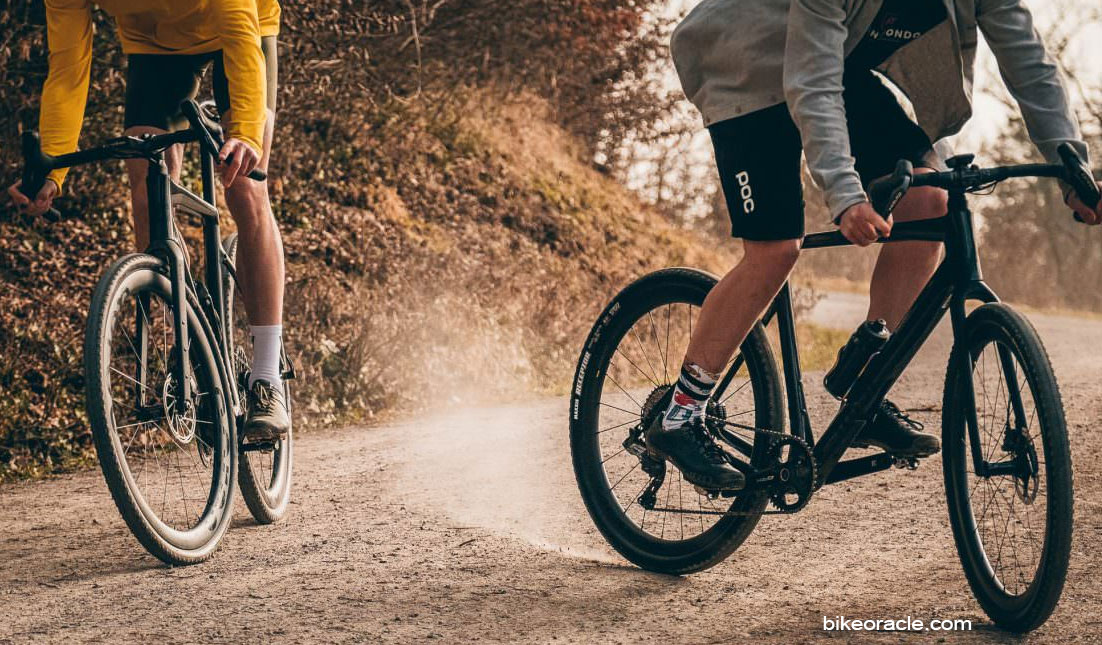Can You Put Gravel Tires On A Road Bike?

In the world of cycling, the boundaries between different bike categories have started to blur as riders seek more versatility and the ability to explore diverse terrains.
One question that often arises is whether it’s possible to put gravel tires on a road bike. This article aims to delve into this topic, exploring the compatibility, benefits, considerations, and techniques associated with using gravel tires on a road bike.
By understanding the key differences between road and gravel bikes, examining the anatomy of gravel tires, and evaluating compatibility factors, riders can make informed decisions about enhancing their road biking experience.
Road Bike vs. Gravel Bike: What’s the Difference?
A. Defining road bikes and their characteristics:
Road bikes are specifically designed for efficient riding on paved roads. They feature lightweight frames, drop handlebars for aerodynamics, and narrow, slick tires that minimize rolling resistance. Road bikes prioritize speed, agility, and smoothness.
B. Introducing gravel bikes and their purpose:
Gravel bikes, also known as adventure or all-road bikes, are built to handle a variety of terrains, including gravel, dirt, and rough pavement. They offer a more relaxed geometry, wider tire clearance, and disc brakes for better control. Gravel bikes are designed for endurance, versatility, and exploration.
C. Key differences between road and gravel bikes:
| Aspect | Road Bike | Gravel Bike |
| Frame geometry | Aggressive and aerodynamic | Relaxed and comfortable |
| Tire clearance | Narrow, limited clearance | Wide, accommodating wider tires |
| Brake type | Caliper brakes (often rim brakes) | Disc brakes (hydraulic or mechanical) |
| Tire width | Typically 23mm-28mm | Can accommodate 32mm-45mm+ gravel tires |
| Riding style | On-road, speed-oriented | Mixed terrain, adventure-oriented |
| Suspension | No suspension | Some models may have front suspension for added comfort |
| Handling and stability | Quick and responsive on smooth pavement | Stable and forgiving on rougher terrain |
Exploring Gravel Tires
A. Understanding the anatomy of a gravel tire:
Gravel tires are specifically designed to handle off-road conditions. They feature a wider profile, aggressive tread patterns, and puncture-resistant casings. The combination of these elements provides improved traction, durability, and reliability on various surfaces.
B. Differentiating gravel tires from road bike tires:
Compared to road bike tires, gravel tires have a larger volume, allowing them to absorb vibrations and provide better shock absorption. The tread patterns are more aggressive, with larger knobs or a file-tread design that grips loose surfaces. Gravel tires are built to withstand the demands of off-road riding.
C. Factors to consider when choosing gravel tires:
- Tread pattern: Select a tread pattern based on the type of terrain you intend to ride on. Aggressive knobs offer better traction in loose conditions, while smoother tread patterns excel on hard-packed surfaces.
- Tire width: Consider the tire clearance of your road bike frame and fork. Opt for the widest tire that fits your bike to maximize comfort and performance.
- Puncture protection: Look for gravel tires with reinforced casings or puncture-resistant layers to minimize the risk of flats on rough terrains.
- Tubeless or tubed: Tubeless tires offer lower rolling resistance and better puncture protection, but require specific rims and sealant. Tubed tires are simpler to maintain and repair but may be slightly heavier.
- Sidewall construction: Consider the durability and suppleness of the sidewall material. Sturdy sidewalls are ideal for rough conditions, while supple side walls offer a smoother ride.
Compatibility: Can You Put Gravel Tires On A Road Bike?
A. Assessing frame and fork clearance:
Before fitting gravel tires on a road bike, it’s essential to check the frame and fork clearance. Gravel tires require more space due to their larger volume. Measure the clearance between the tire and the closest point on the frame and fork to ensure adequate space for the desired tire width.
B. Evaluating brake and tire clearance:
Road bikes typically come with caliper brakes, which have limited clearance. Switching to gravel tires may necessitate upgrading to disc brakes, which offer better clearance for wider tires. Ensure that your road bike’s brake system is compatible with the desired tire width.
C. Potential challenges of fitting gravel tires on a road bike:
Converting a road bike to accommodate gravel tires may present a few challenges. Some road bike frames have limited tire clearance, preventing the use of wider tires. Additionally, caliper brakes may not provide sufficient clearance for larger gravel tires. In such cases, modifying the bike’s frame or upgrading components may be necessary.
Benefits of Using Gravel Tires on a Road Bike
A. Improved traction on varied surfaces:
Gravel tires offer superior grip on loose surfaces, such as gravel, dirt, and grass. By providing increased traction, these tires enhance your ability to ride confidently on a variety of terrains, even in wet or muddy conditions.
B. Enhanced comfort and shock absorption:
The wider profile and larger air volume of gravel tires contribute to a more comfortable ride. They absorb vibrations and impact from rough roads, resulting in reduced fatigue and a smoother cycling experience.
C. Increased versatility for riding different terrains:
By fitting gravel tires on a road bike, you unlock new possibilities for exploration. You can venture off the beaten path and discover gravel roads, fire trails, and scenic off-road routes while still maintaining the option to ride on paved roads with ease.
Considerations Before Putting Gravel Tires on a Road Bike
A. Frame and fork limitations:
Before making the switch, ensure that your road bike’s frame and fork can accommodate the desired gravel tire width. Check the manufacturer’s specifications or consult a professional bike fitter if you’re unsure.
B. Brake compatibility and adjustments:
If your road bike has caliper brakes, they may not provide sufficient clearance for wider gravel tires. Consider upgrading to disc brakes, which offer better compatibility and stopping power. Additionally, adjusting the brake pads and cable tension may be necessary to accommodate the increased tire width.
C. Wheel size and tire width considerations:
Road bikes typically feature 700c wheels, while gravel bikes often have 700c or 650b options. Verify that your road bike’s wheel size is compatible with the desired gravel tires. Additionally, consider the maximum tire width your rims can safely accommodate to avoid issues with tire stability and clearance.
Converting a Road Bike to a Gravel Bike
A. Upgrading to accommodate wider tires:
To fit gravel tires on a road bike, you may need to upgrade various components. This includes swapping out the existing narrow rims for wider ones, replacing caliper brakes with disc brakes, and adjusting the frame and fork to provide adequate clearance.
B. Adjusting the bike’s geometry for better stability:
Gravel bikes typically have a more relaxed geometry than road bikes to provide stability on uneven terrain. While converting a road bike, you can adjust the handlebar height, stem length, and saddle position to achieve a more upright and comfortable riding position.
C. Potential modifications for an optimal gravel riding experience:
Depending on your preferences and riding style, you may consider additional modifications. These can include adding accessories such as fender mounts, installing a dropper seatpost for better maneuverability, or incorporating frame bags for carrying supplies on longer gravel adventures.
Tire Pressure and Performance

A. Understanding the importance of tire pressure:
Tire pressure plays a crucial role in performance and comfort. It affects traction, rolling resistance, and the tire’s ability to absorb shocks. Finding the right tire pressure is a balancing act that depends on factors such as rider weight, tire volume, and terrain conditions.
B. Finding the ideal tire pressure for gravel riding:
Gravel tire pressure is typically lower than that of road tires. It allows for better traction and shock absorption on uneven surfaces. Experiment with different pressures to find the sweet spot that balances comfort, traction, and rolling efficiency for your weight and riding style.
C. Balancing traction, speed, and comfort:
Optimal tire pressure depends on the specific gravel conditions you’ll encounter. Lower pressures provide increased traction on loose surfaces but may compromise rolling efficiency on smoother roads. Higher pressures enhance speed but may result in a harsher ride. Strike a balance based on your intended terrain and personal preferences.
Exploring Different Gravel Tire Options
A. Tubeless vs. tubed gravel tires:
| Aspect | Tubeless Gravel Tires | Tubed Gravel Tires |
| Puncture resistance | Excellent puncture protection with sealant | Relies on inner tubes for puncture resistance |
| Rolling efficiency | Lower rolling resistance due to absence of tubes | Slightly higher rolling resistance due to inner tubes |
| Self-sealing ability | Can seal small punctures automatically | Requires manual puncture repair or tube replacement |
| Weight | Typically lighter due to no tubes | Slightly heavier due to tubes |
B. Tread patterns and their effects on performance
Gravel tires come in a variety of tread patterns suited for different terrains. Aggressive knobs provide exceptional traction on loose surfaces, while smoother file-tread designs excel on hard-packed gravel. Consider the primary surfaces you’ll ride on to choose an appropriate tread pattern.
C. Selecting the right tire width for your road bike
The tire width you choose should align with your road bike’s frame and fork clearance. Wider tires offer increased comfort and traction but may not fit all road bike models. Consider the trade-off between tire width, frame compatibility, and the desired performance benefits when making your selection.
Riding Techniques with Gravel Tires on a Road Bike
A. Adapting to different road and gravel surfaces:
Gravel tires introduce new dynamics to your road bike, requiring adjustments in riding technique. Learn to anticipate the behavior of the tires on loose surfaces, practice maintaining balance on uneven terrain, and adapt your cornering technique for increased traction.
B. Cornering and handling considerations:
Gravel tires may alter the handling characteristics of your road bike. They typically require a more upright riding position and a wider turning radius. Practice cornering techniques, weight distribution, and braking adjustments to maintain control and stability while riding with gravel tires.
C. Tips for maintaining stability and control:
To ensure stability and control, maintain a relaxed grip on the handlebars, distribute your weight evenly, and keep your eyes focused on the path ahead. Gradually adjust your riding style to suit the demands of gravel riding, and practice in various conditions to enhance your skills.
Maintenance and Care for Gravel Tires
A. Regular tire inspections and maintenance:
Perform regular inspections of your gravel tires to check for cuts, punctures, or signs of wear. Remove any embedded debris, and inspect the sidewalls for damage. Maintain proper tire pressure and periodically clean the tires to remove accumulated dirt and debris.
B. Dealing with punctures and flats on the road:
Carry a puncture repair kit or spare tubes when riding with gravel tires. Familiarize yourself with basic tire repair techniques and carry the necessary tools. In the event of a flat tire, find a safe spot to repair or replace the tube and continue your ride.
C. Extending the lifespan of your gravel tires:
To prolong the lifespan of your gravel tires, avoid riding them on surfaces that can cause excessive wear, such as rough pavement or sharp rocks. Additionally, clean the tires regularly, store them away from direct sunlight, and replace them when the tread wears down significantly.
Safety Considerations when Riding with Gravel Tires
A. Adjusting riding style for varied terrains:
Gravel riding introduces new challenges, and adapting your riding style is crucial for safety. Slow down on loose surfaces, maintain a firm grip on the handlebars, and be prepared for sudden changes in traction. Ride within your limits and gradually build your confidence on different terrains.
B. Ensuring proper braking and handling:
Gravel tires require adjustments in braking technique. Familiarize yourself with the performance characteristics of your brakes on different surfaces and practice modulating your braking force. Maintain control of your bike by keeping a relaxed upper body and using proper weight distribution.
C. Protective gear and equipment recommendations:
When riding with gravel tires, prioritize safety by wearing a well-fitted helmet, appropriate cycling clothing, and protective eyewear. Consider using gloves for better grip and protection, and outfit your bike with reflectors and lights to enhance visibility, especially when riding in low-light conditions.
Pros and Cons of Using Gravel Tires on a Road Bike
A. Benefits of gravel tires on a road bike:
- Improved traction on varied surfaces, enhancing confidence and control.
- Enhanced comfort and shock absorption for a smoother ride.
- Increased versatility, allowing riders to explore off-road paths while still maintaining road capabilities.
- Access to new routes and scenic landscapes, expanding riding possibilities.
B. Drawbacks and limitations to consider:
- Potential challenges in frame and fork clearance, requiring modifications or upgrades.
- Additional weight compared to traditional road tires, affecting rolling efficiency to some extent.
- Altered handling characteristics, requiring adjustments to riding technique and cornering.
C. Personal preferences and individual riding styles:
Ultimately, the decision to use gravel tires on a road bike depends on personal preferences and individual riding styles. Consider your desired riding experience, the terrain you’ll encounter most frequently, and the trade-offs you’re willing to make in terms of performance and convenience.
Testimonials from Road Cyclists Using Gravel Tires
A. Real-life experiences from road cyclists:
“I never thought I could enjoy gravel riding on my road bike until I tried gravel tires. It opened up a whole new world of adventure!” – Sarah
“Gravel tires transformed my road bike into a versatile all-rounder. I can now explore country roads and forest trails without hesitation.” – Mark
B. Insights into the advantages and challenges:
“The added traction and comfort of gravel tires make a significant difference on rough roads. However, they do require some adjustments in handling and braking.” – Emma
“I had to upgrade my brakes and widen my frame, but it was worth it. Riding gravel has become my favorite weekend escape.” – David
C. Inspirational stories of exploring new routes and terrains:
“Thanks to gravel tires, I discovered hidden gems in my local area. I now seek out unpaved paths and enjoy the thrill of exploring the unknown.” – Lisa
“Riding my road bike with gravel tires allowed me to participate in gravel races and push my limits. It’s a whole new dimension of cycling!” – Alex
Conclusion
In conclusion, fitting gravel tires on a road bike opens up exciting possibilities for road cyclists seeking versatility and off-road exploration. While there are considerations and potential modifications involved, the benefits of improved traction, enhanced comfort, and increased versatility make the transformation worthwhile for many riders.
By understanding the differences between road and gravel bikes, assessing compatibility, and selecting appropriate tires, road cyclists can enjoy the thrill of gravel riding without investing in a separate bike.
So, if you’re ready to expand your horizons and embrace the adventure, don’t hesitate to put gravel tires on your road bike and embark on a whole new cycling experience. Happy riding!

![How Fast Does a 750w Electric Bike Go? [Answered]](https://bikeoracle.com/wp-content/uploads/2023/10/Fast-Does-a-750w-Electric-Bike-Go-768x512.png)


![Is Mongoose a Good Bike Brand? [Answered]](https://bikeoracle.com/wp-content/uploads/2023/09/Is-Mongoose-a-Good-Bike-Brand-768x512.jpg)
![Unveiling the Velocity: How Fast Can a 48V e-bike Go? [Answered]](https://bikeoracle.com/wp-content/uploads/2023/10/How-Fast-Can-a-48V-e-bike-Go-768x512.jpg)